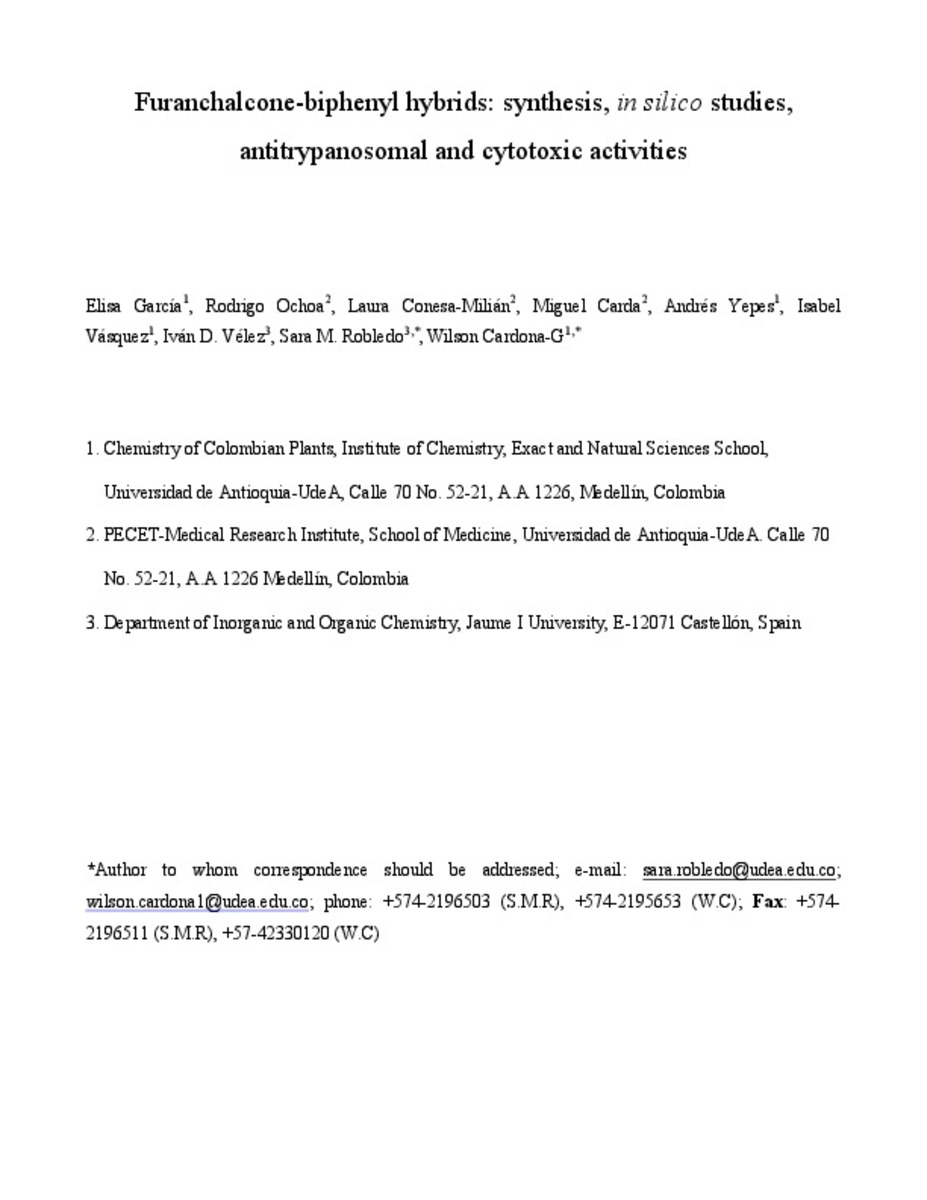Mostrar el registro sencillo del ítem
Furanchalcone–biphenyl hybrids: synthesis, in silico studies, antitrypanosomal and cytotoxic activities
| dc.contributor.author | García, Elisa | |
| dc.contributor.author | Ochoa, Rodrigo | |
| dc.contributor.author | Vasquez, Isabel | |
| dc.contributor.author | Conesa Milián, Laura | |
| dc.contributor.author | Carda, Miguel | |
| dc.contributor.author | Yepes, Andrés | |
| dc.contributor.author | Vélez, Iván D. | |
| dc.contributor.author | Robledo, Sara M. | |
| dc.contributor.author | Cardona Galeano, Wilson Isidro | |
| dc.date.accessioned | 2019-05-09T10:02:12Z | |
| dc.date.available | 2019-05-09T10:02:12Z | |
| dc.date.issued | 2019 | |
| dc.identifier.citation | García, E., Ochoa, R., Vásquez, I. et al. Med Chem Res (2019) 28: 608. https://doi.org/10.1007/s00044-019-02323-7 | ca_CA |
| dc.identifier.issn | 1054-2523 | |
| dc.identifier.issn | 1554-8120 | |
| dc.identifier.uri | http://hdl.handle.net/10234/182449 | |
| dc.description.abstract | The synthesis, antitrypanosomal, and cytotoxic activities of 17 furanchalcone derivatives are described herein. The structure of the synthesized products was elucidated by a combination of spectrometric analyses. The synthesized compounds were evaluated against Trypanosoma cruzi, which is the pathogenic species to humans. Cytotoxicity was evaluated against human U-937 macrophages. Eleven compounds were active against amastigotes of T. cruzi with EC50 values lower than 40 µM. Hybrids 7b–7d and 8a–8g showed better activity than benznidazole. Structure activity relationship (SAR) showed that the presence of electron withdrawing groups, such as nitro or fluorine, increased the activity and that the degree of oxygenation is essential for activity. In addition, molecular docking was used to identify a possible protein target for the designed compounds. A spearman correlation of 0.608 between the predicted scores and the experimental data profile the enzyme cruzipain as a potential candidate. Finally, in silico ADMET studies of the arylfuranchalcones showed that these novel compounds have suitable drug-like properties, making them potentially promising agents for antichagasic therapy. | ca_CA |
| dc.format.extent | 30 p. | ca_CA |
| dc.format.mimetype | application/pdf | ca_CA |
| dc.language.iso | eng | ca_CA |
| dc.publisher | Springer Verlag | ca_CA |
| dc.relation.isPartOf | Medicinal Chemistry Research (2019) 28 | ca_CA |
| dc.rights | © Springer Science+Business Media, LLC, part of Springer Nature 2019 “This is a post-peer-review, pre-copyedit version of an article published in Medicinal Chemistry Research. The final authenticated version is available online at: https://doi.org/10.1007/s00044-019-02323-7” | ca_CA |
| dc.rights.uri | http://rightsstatements.org/vocab/InC/1.0/ | * |
| dc.subject | Chagas disease | ca_CA |
| dc.subject | Trypanosoma cruzi | ca_CA |
| dc.subject | Furanchalcone | ca_CA |
| dc.subject | Hybrids | ca_CA |
| dc.subject | In silico studies | ca_CA |
| dc.subject | Biphenyl | ca_CA |
| dc.title | Furanchalcone–biphenyl hybrids: synthesis, in silico studies, antitrypanosomal and cytotoxic activities | ca_CA |
| dc.type | info:eu-repo/semantics/article | ca_CA |
| dc.identifier.doi | https://doi.org/10.1007/s00044-019-02323-7 | |
| dc.relation.projectID | CODI 6203 | ca_CA |
| dc.rights.accessRights | info:eu-repo/semantics/openAccess | ca_CA |
| dc.relation.publisherVersion | https://link.springer.com/article/10.1007/s00044-019-02323-7 | ca_CA |
| dc.date.embargoEndDate | 2020-03-11 | |
| dc.type.version | info:eu-repo/semantics/acceptedVersion | ca_CA |
Ficheros en el ítem
Este ítem aparece en la(s) siguiente(s) colección(ones)
-
QUIO_Articles [690]
Articles de publicacions periòdiques







